The Role of Reflection in Higher Education Orientation Programs
VerifiedAdded on 2023/06/11
|7
|1909
|108
Essay
AI Summary
This essay delves into the concept of reflective learning within the context of higher education orientation, emphasizing its significance in enhancing students' learning experiences. It discusses the Gibbs Reflective Cycle, outlining its six stages—Description, Feelings, Evaluation, Analysis, Conclusion, and Action Plan—to provide a structured approach for students to learn from their experiences. The essay also explores the nature of feedback and feedforward, highlighting their roles in guiding students toward improvement and future success. Furthermore, it underscores the importance of continuous feedback from teachers and the application of reflective practices in both formative and summative assessments, ultimately fostering self-confidence and developed working habits in students. The document elucidates how reflective learning, coupled with effective feedback mechanisms, prepares students to navigate challenges, achieve their goals, and cultivate a proactive approach to their academic endeavors. Desklib provides a platform for students to access similar solved assignments and past papers.
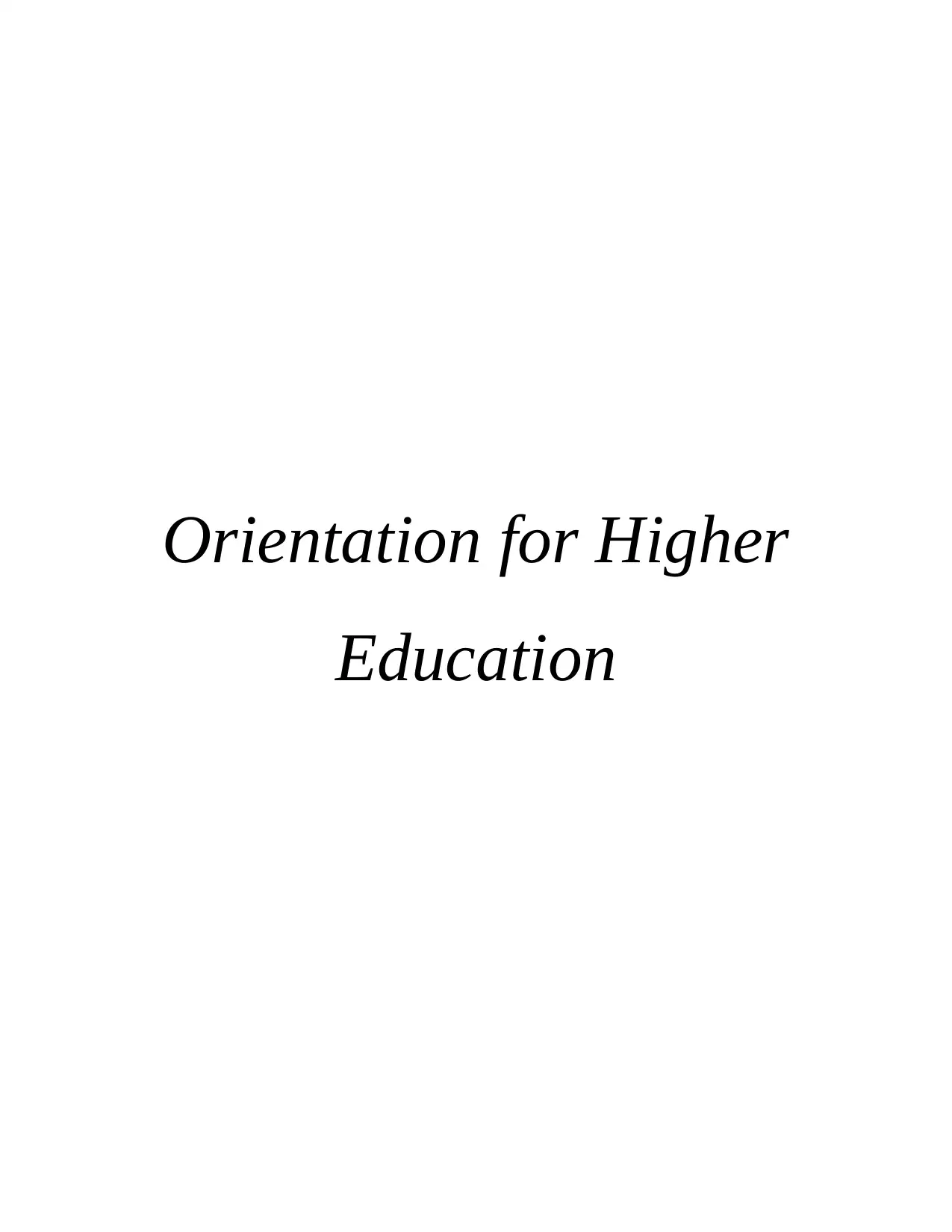
Orientation for Higher
Education
Education
Paraphrase This Document
Need a fresh take? Get an instant paraphrase of this document with our AI Paraphraser
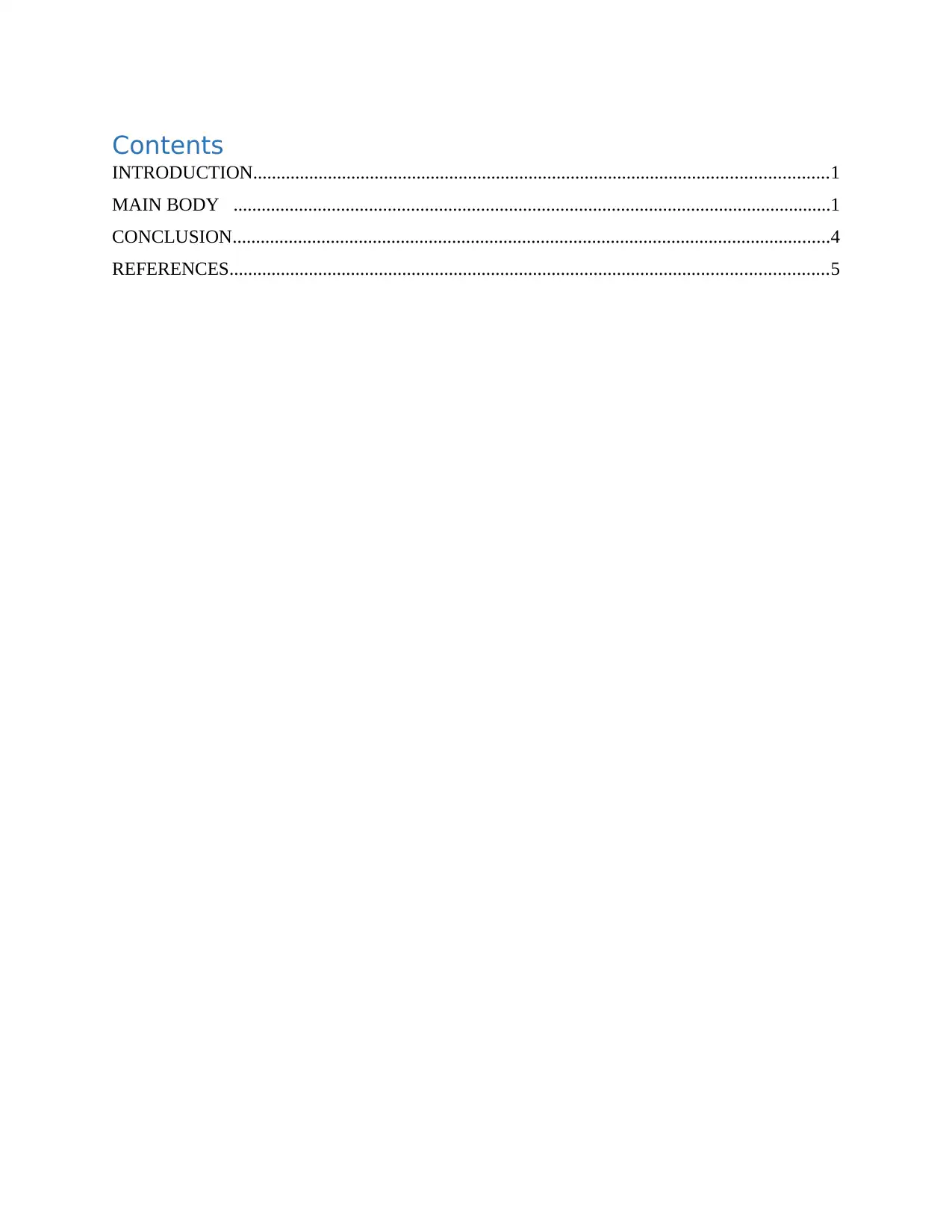
Contents
INTRODUCTION...........................................................................................................................1
MAIN BODY ................................................................................................................................1
CONCLUSION................................................................................................................................4
REFERENCES................................................................................................................................5
INTRODUCTION...........................................................................................................................1
MAIN BODY ................................................................................................................................1
CONCLUSION................................................................................................................................4
REFERENCES................................................................................................................................5
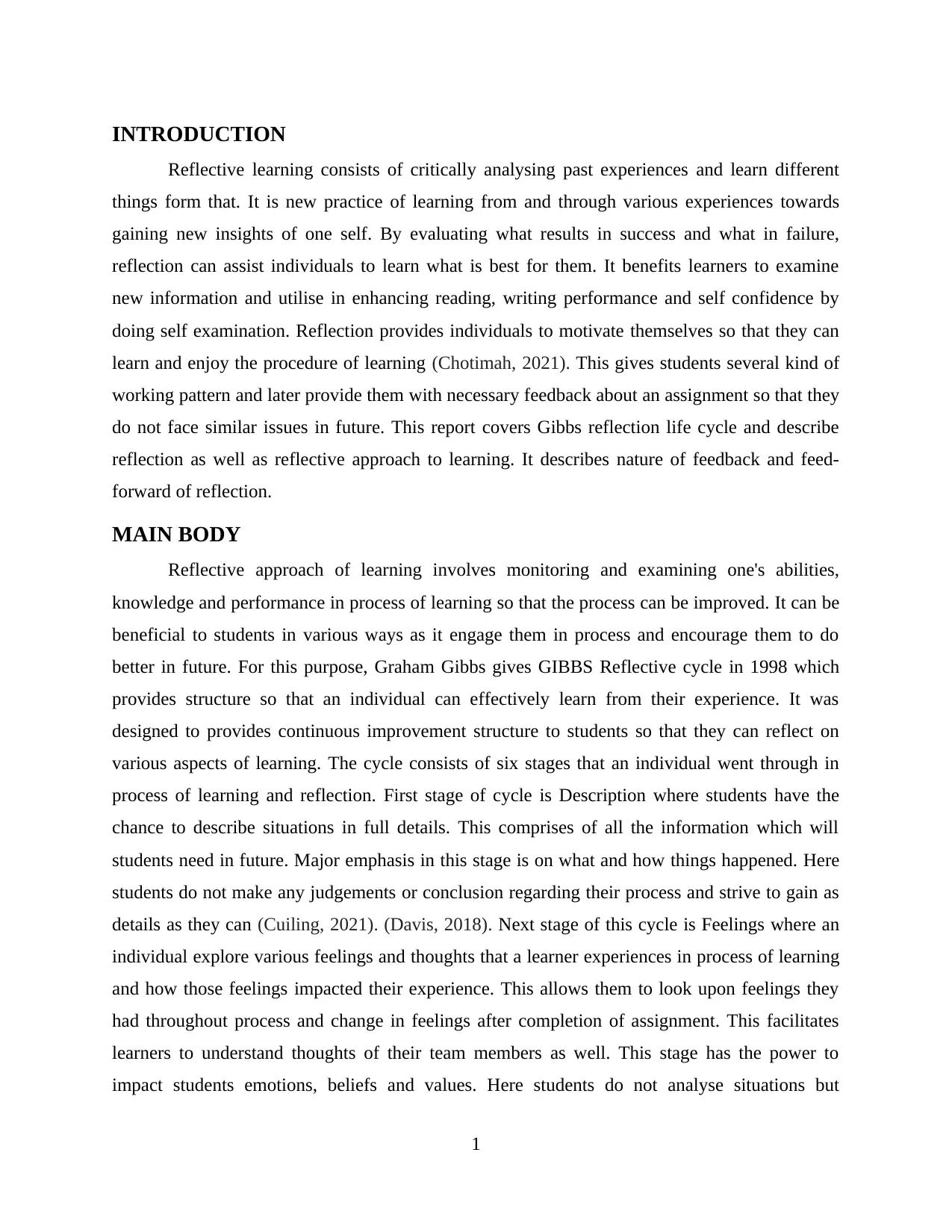
INTRODUCTION
Reflective learning consists of critically analysing past experiences and learn different
things form that. It is new practice of learning from and through various experiences towards
gaining new insights of one self. By evaluating what results in success and what in failure,
reflection can assist individuals to learn what is best for them. It benefits learners to examine
new information and utilise in enhancing reading, writing performance and self confidence by
doing self examination. Reflection provides individuals to motivate themselves so that they can
learn and enjoy the procedure of learning (Chotimah, 2021). This gives students several kind of
working pattern and later provide them with necessary feedback about an assignment so that they
do not face similar issues in future. This report covers Gibbs reflection life cycle and describe
reflection as well as reflective approach to learning. It describes nature of feedback and feed-
forward of reflection.
MAIN BODY
Reflective approach of learning involves monitoring and examining one's abilities,
knowledge and performance in process of learning so that the process can be improved. It can be
beneficial to students in various ways as it engage them in process and encourage them to do
better in future. For this purpose, Graham Gibbs gives GIBBS Reflective cycle in 1998 which
provides structure so that an individual can effectively learn from their experience. It was
designed to provides continuous improvement structure to students so that they can reflect on
various aspects of learning. The cycle consists of six stages that an individual went through in
process of learning and reflection. First stage of cycle is Description where students have the
chance to describe situations in full details. This comprises of all the information which will
students need in future. Major emphasis in this stage is on what and how things happened. Here
students do not make any judgements or conclusion regarding their process and strive to gain as
details as they can (Cuiling, 2021). (Davis, 2018). Next stage of this cycle is Feelings where an
individual explore various feelings and thoughts that a learner experiences in process of learning
and how those feelings impacted their experience. This allows them to look upon feelings they
had throughout process and change in feelings after completion of assignment. This facilitates
learners to understand thoughts of their team members as well. This stage has the power to
impact students emotions, beliefs and values. Here students do not analyse situations but
1
Reflective learning consists of critically analysing past experiences and learn different
things form that. It is new practice of learning from and through various experiences towards
gaining new insights of one self. By evaluating what results in success and what in failure,
reflection can assist individuals to learn what is best for them. It benefits learners to examine
new information and utilise in enhancing reading, writing performance and self confidence by
doing self examination. Reflection provides individuals to motivate themselves so that they can
learn and enjoy the procedure of learning (Chotimah, 2021). This gives students several kind of
working pattern and later provide them with necessary feedback about an assignment so that they
do not face similar issues in future. This report covers Gibbs reflection life cycle and describe
reflection as well as reflective approach to learning. It describes nature of feedback and feed-
forward of reflection.
MAIN BODY
Reflective approach of learning involves monitoring and examining one's abilities,
knowledge and performance in process of learning so that the process can be improved. It can be
beneficial to students in various ways as it engage them in process and encourage them to do
better in future. For this purpose, Graham Gibbs gives GIBBS Reflective cycle in 1998 which
provides structure so that an individual can effectively learn from their experience. It was
designed to provides continuous improvement structure to students so that they can reflect on
various aspects of learning. The cycle consists of six stages that an individual went through in
process of learning and reflection. First stage of cycle is Description where students have the
chance to describe situations in full details. This comprises of all the information which will
students need in future. Major emphasis in this stage is on what and how things happened. Here
students do not make any judgements or conclusion regarding their process and strive to gain as
details as they can (Cuiling, 2021). (Davis, 2018). Next stage of this cycle is Feelings where an
individual explore various feelings and thoughts that a learner experiences in process of learning
and how those feelings impacted their experience. This allows them to look upon feelings they
had throughout process and change in feelings after completion of assignment. This facilitates
learners to understand thoughts of their team members as well. This stage has the power to
impact students emotions, beliefs and values. Here students do not analyse situations but
1
⊘ This is a preview!⊘
Do you want full access?
Subscribe today to unlock all pages.

Trusted by 1+ million students worldwide
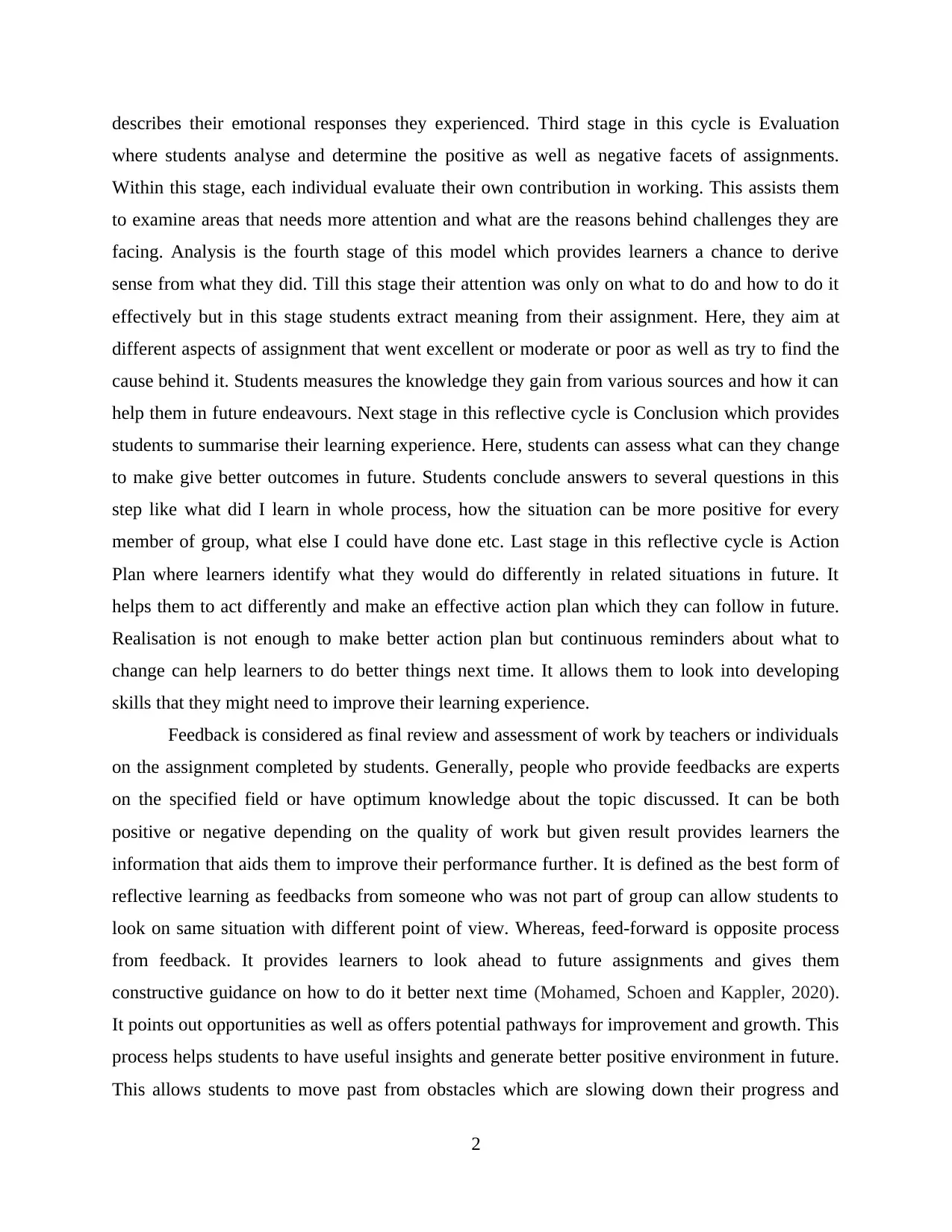
describes their emotional responses they experienced. Third stage in this cycle is Evaluation
where students analyse and determine the positive as well as negative facets of assignments.
Within this stage, each individual evaluate their own contribution in working. This assists them
to examine areas that needs more attention and what are the reasons behind challenges they are
facing. Analysis is the fourth stage of this model which provides learners a chance to derive
sense from what they did. Till this stage their attention was only on what to do and how to do it
effectively but in this stage students extract meaning from their assignment. Here, they aim at
different aspects of assignment that went excellent or moderate or poor as well as try to find the
cause behind it. Students measures the knowledge they gain from various sources and how it can
help them in future endeavours. Next stage in this reflective cycle is Conclusion which provides
students to summarise their learning experience. Here, students can assess what can they change
to make give better outcomes in future. Students conclude answers to several questions in this
step like what did I learn in whole process, how the situation can be more positive for every
member of group, what else I could have done etc. Last stage in this reflective cycle is Action
Plan where learners identify what they would do differently in related situations in future. It
helps them to act differently and make an effective action plan which they can follow in future.
Realisation is not enough to make better action plan but continuous reminders about what to
change can help learners to do better things next time. It allows them to look into developing
skills that they might need to improve their learning experience.
Feedback is considered as final review and assessment of work by teachers or individuals
on the assignment completed by students. Generally, people who provide feedbacks are experts
on the specified field or have optimum knowledge about the topic discussed. It can be both
positive or negative depending on the quality of work but given result provides learners the
information that aids them to improve their performance further. It is defined as the best form of
reflective learning as feedbacks from someone who was not part of group can allow students to
look on same situation with different point of view. Whereas, feed-forward is opposite process
from feedback. It provides learners to look ahead to future assignments and gives them
constructive guidance on how to do it better next time (Mohamed, Schoen and Kappler, 2020).
It points out opportunities as well as offers potential pathways for improvement and growth. This
process helps students to have useful insights and generate better positive environment in future.
This allows students to move past from obstacles which are slowing down their progress and
2
where students analyse and determine the positive as well as negative facets of assignments.
Within this stage, each individual evaluate their own contribution in working. This assists them
to examine areas that needs more attention and what are the reasons behind challenges they are
facing. Analysis is the fourth stage of this model which provides learners a chance to derive
sense from what they did. Till this stage their attention was only on what to do and how to do it
effectively but in this stage students extract meaning from their assignment. Here, they aim at
different aspects of assignment that went excellent or moderate or poor as well as try to find the
cause behind it. Students measures the knowledge they gain from various sources and how it can
help them in future endeavours. Next stage in this reflective cycle is Conclusion which provides
students to summarise their learning experience. Here, students can assess what can they change
to make give better outcomes in future. Students conclude answers to several questions in this
step like what did I learn in whole process, how the situation can be more positive for every
member of group, what else I could have done etc. Last stage in this reflective cycle is Action
Plan where learners identify what they would do differently in related situations in future. It
helps them to act differently and make an effective action plan which they can follow in future.
Realisation is not enough to make better action plan but continuous reminders about what to
change can help learners to do better things next time. It allows them to look into developing
skills that they might need to improve their learning experience.
Feedback is considered as final review and assessment of work by teachers or individuals
on the assignment completed by students. Generally, people who provide feedbacks are experts
on the specified field or have optimum knowledge about the topic discussed. It can be both
positive or negative depending on the quality of work but given result provides learners the
information that aids them to improve their performance further. It is defined as the best form of
reflective learning as feedbacks from someone who was not part of group can allow students to
look on same situation with different point of view. Whereas, feed-forward is opposite process
from feedback. It provides learners to look ahead to future assignments and gives them
constructive guidance on how to do it better next time (Mohamed, Schoen and Kappler, 2020).
It points out opportunities as well as offers potential pathways for improvement and growth. This
process helps students to have useful insights and generate better positive environment in future.
This allows students to move past from obstacles which are slowing down their progress and
2
Paraphrase This Document
Need a fresh take? Get an instant paraphrase of this document with our AI Paraphraser
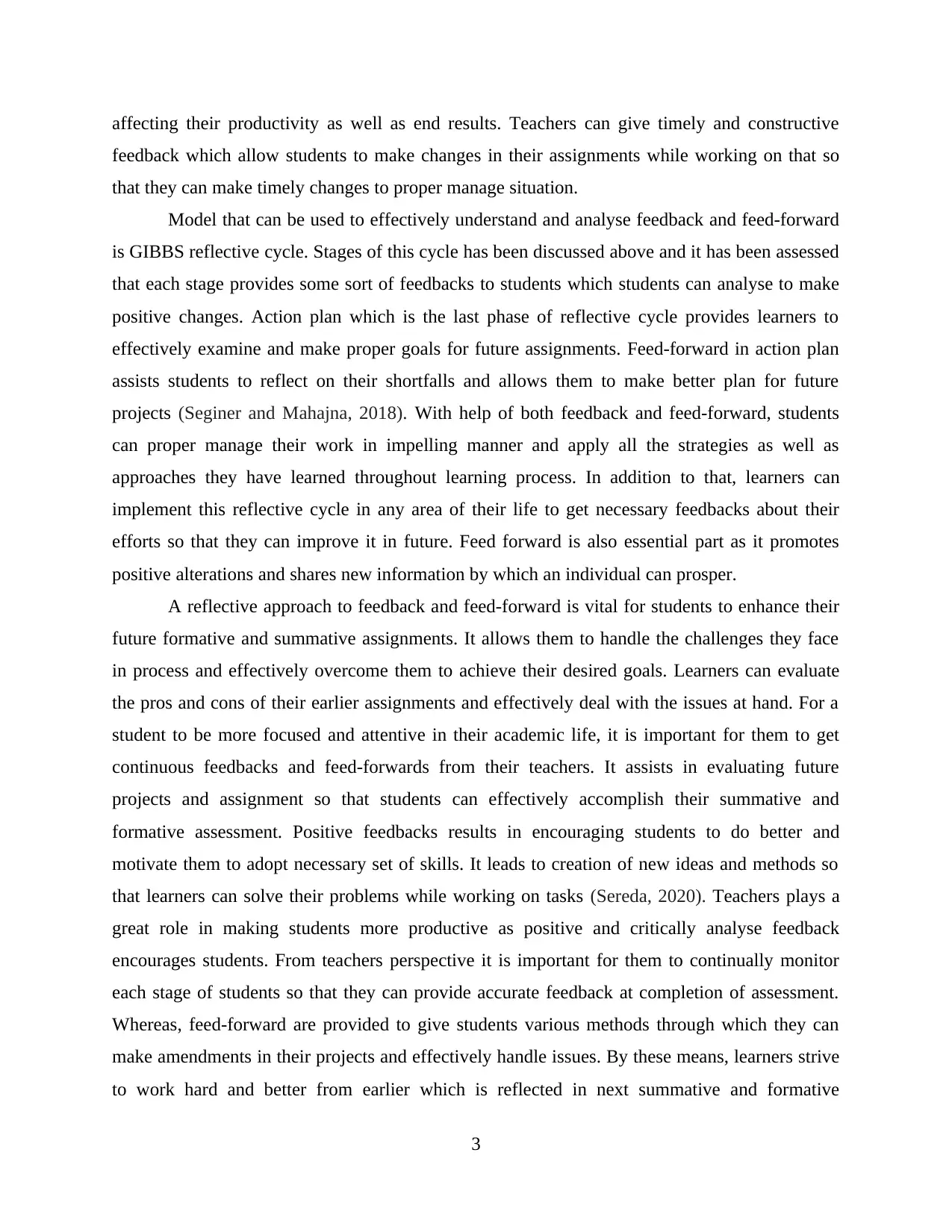
affecting their productivity as well as end results. Teachers can give timely and constructive
feedback which allow students to make changes in their assignments while working on that so
that they can make timely changes to proper manage situation.
Model that can be used to effectively understand and analyse feedback and feed-forward
is GIBBS reflective cycle. Stages of this cycle has been discussed above and it has been assessed
that each stage provides some sort of feedbacks to students which students can analyse to make
positive changes. Action plan which is the last phase of reflective cycle provides learners to
effectively examine and make proper goals for future assignments. Feed-forward in action plan
assists students to reflect on their shortfalls and allows them to make better plan for future
projects (Seginer and Mahajna, 2018). With help of both feedback and feed-forward, students
can proper manage their work in impelling manner and apply all the strategies as well as
approaches they have learned throughout learning process. In addition to that, learners can
implement this reflective cycle in any area of their life to get necessary feedbacks about their
efforts so that they can improve it in future. Feed forward is also essential part as it promotes
positive alterations and shares new information by which an individual can prosper.
A reflective approach to feedback and feed-forward is vital for students to enhance their
future formative and summative assignments. It allows them to handle the challenges they face
in process and effectively overcome them to achieve their desired goals. Learners can evaluate
the pros and cons of their earlier assignments and effectively deal with the issues at hand. For a
student to be more focused and attentive in their academic life, it is important for them to get
continuous feedbacks and feed-forwards from their teachers. It assists in evaluating future
projects and assignment so that students can effectively accomplish their summative and
formative assessment. Positive feedbacks results in encouraging students to do better and
motivate them to adopt necessary set of skills. It leads to creation of new ideas and methods so
that learners can solve their problems while working on tasks (Sereda, 2020). Teachers plays a
great role in making students more productive as positive and critically analyse feedback
encourages students. From teachers perspective it is important for them to continually monitor
each stage of students so that they can provide accurate feedback at completion of assessment.
Whereas, feed-forward are provided to give students various methods through which they can
make amendments in their projects and effectively handle issues. By these means, learners strive
to work hard and better from earlier which is reflected in next summative and formative
3
feedback which allow students to make changes in their assignments while working on that so
that they can make timely changes to proper manage situation.
Model that can be used to effectively understand and analyse feedback and feed-forward
is GIBBS reflective cycle. Stages of this cycle has been discussed above and it has been assessed
that each stage provides some sort of feedbacks to students which students can analyse to make
positive changes. Action plan which is the last phase of reflective cycle provides learners to
effectively examine and make proper goals for future assignments. Feed-forward in action plan
assists students to reflect on their shortfalls and allows them to make better plan for future
projects (Seginer and Mahajna, 2018). With help of both feedback and feed-forward, students
can proper manage their work in impelling manner and apply all the strategies as well as
approaches they have learned throughout learning process. In addition to that, learners can
implement this reflective cycle in any area of their life to get necessary feedbacks about their
efforts so that they can improve it in future. Feed forward is also essential part as it promotes
positive alterations and shares new information by which an individual can prosper.
A reflective approach to feedback and feed-forward is vital for students to enhance their
future formative and summative assignments. It allows them to handle the challenges they face
in process and effectively overcome them to achieve their desired goals. Learners can evaluate
the pros and cons of their earlier assignments and effectively deal with the issues at hand. For a
student to be more focused and attentive in their academic life, it is important for them to get
continuous feedbacks and feed-forwards from their teachers. It assists in evaluating future
projects and assignment so that students can effectively accomplish their summative and
formative assessment. Positive feedbacks results in encouraging students to do better and
motivate them to adopt necessary set of skills. It leads to creation of new ideas and methods so
that learners can solve their problems while working on tasks (Sereda, 2020). Teachers plays a
great role in making students more productive as positive and critically analyse feedback
encourages students. From teachers perspective it is important for them to continually monitor
each stage of students so that they can provide accurate feedback at completion of assessment.
Whereas, feed-forward are provided to give students various methods through which they can
make amendments in their projects and effectively handle issues. By these means, learners strive
to work hard and better from earlier which is reflected in next summative and formative
3
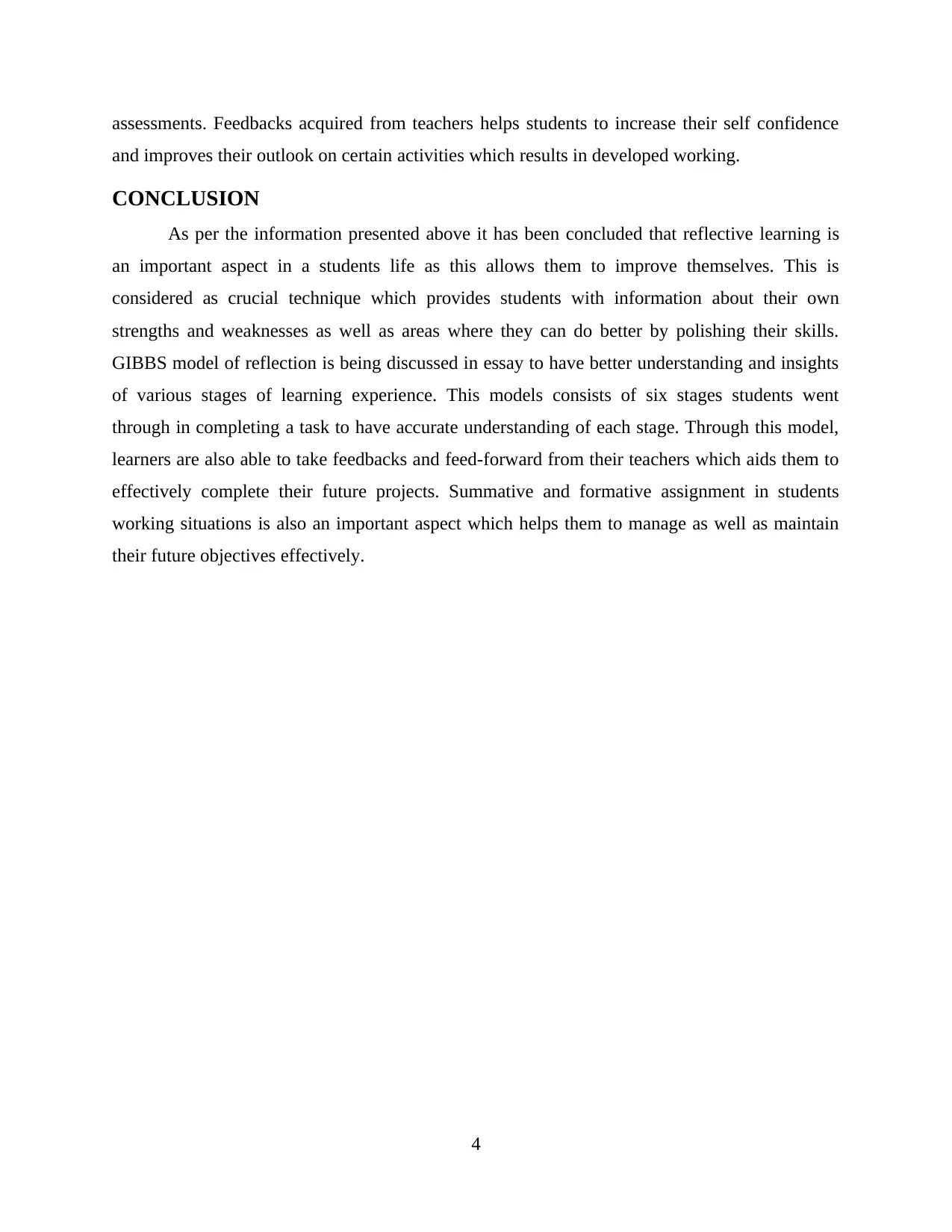
assessments. Feedbacks acquired from teachers helps students to increase their self confidence
and improves their outlook on certain activities which results in developed working.
CONCLUSION
As per the information presented above it has been concluded that reflective learning is
an important aspect in a students life as this allows them to improve themselves. This is
considered as crucial technique which provides students with information about their own
strengths and weaknesses as well as areas where they can do better by polishing their skills.
GIBBS model of reflection is being discussed in essay to have better understanding and insights
of various stages of learning experience. This models consists of six stages students went
through in completing a task to have accurate understanding of each stage. Through this model,
learners are also able to take feedbacks and feed-forward from their teachers which aids them to
effectively complete their future projects. Summative and formative assignment in students
working situations is also an important aspect which helps them to manage as well as maintain
their future objectives effectively.
4
and improves their outlook on certain activities which results in developed working.
CONCLUSION
As per the information presented above it has been concluded that reflective learning is
an important aspect in a students life as this allows them to improve themselves. This is
considered as crucial technique which provides students with information about their own
strengths and weaknesses as well as areas where they can do better by polishing their skills.
GIBBS model of reflection is being discussed in essay to have better understanding and insights
of various stages of learning experience. This models consists of six stages students went
through in completing a task to have accurate understanding of each stage. Through this model,
learners are also able to take feedbacks and feed-forward from their teachers which aids them to
effectively complete their future projects. Summative and formative assignment in students
working situations is also an important aspect which helps them to manage as well as maintain
their future objectives effectively.
4
⊘ This is a preview!⊘
Do you want full access?
Subscribe today to unlock all pages.

Trusted by 1+ million students worldwide
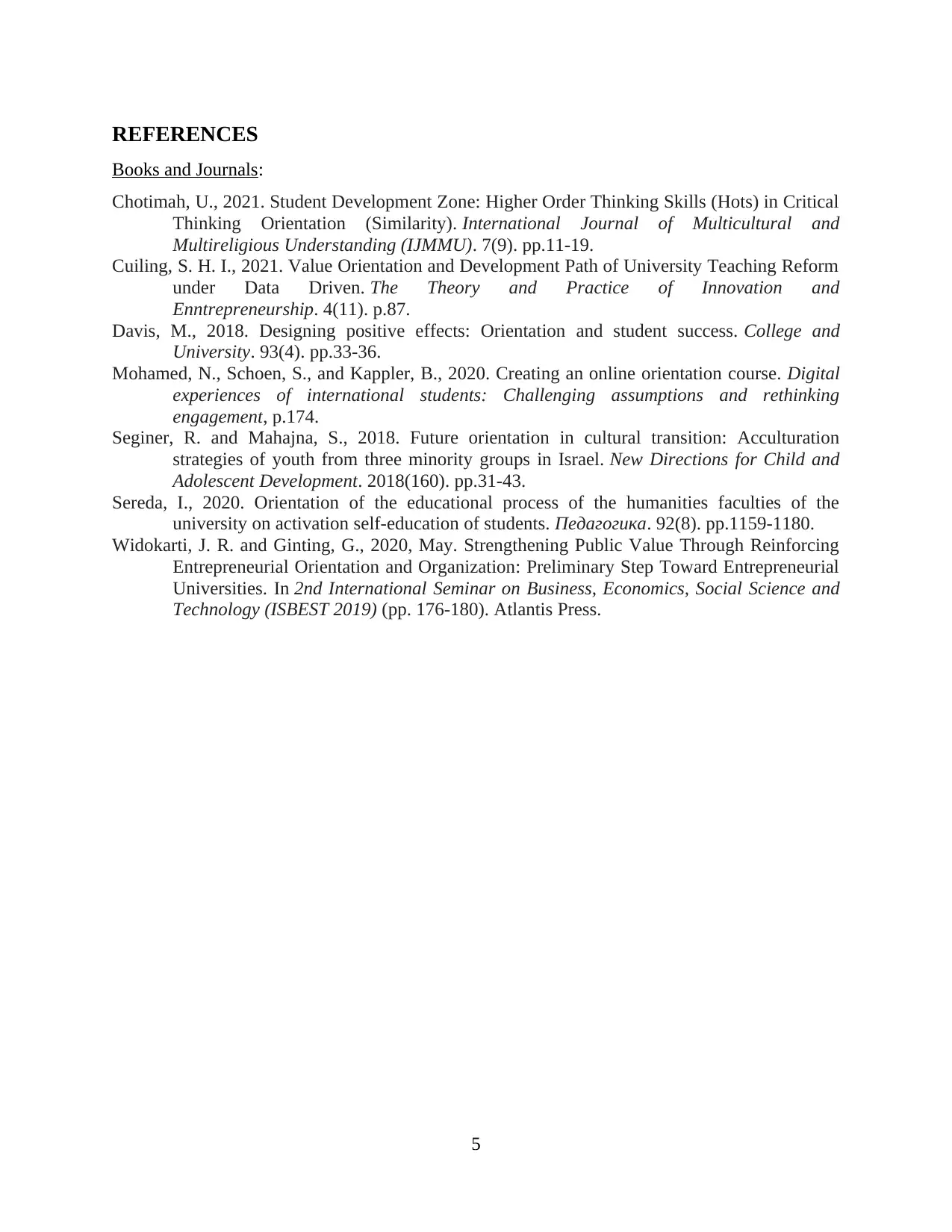
REFERENCES
Books and Journals:
Chotimah, U., 2021. Student Development Zone: Higher Order Thinking Skills (Hots) in Critical
Thinking Orientation (Similarity). International Journal of Multicultural and
Multireligious Understanding (IJMMU). 7(9). pp.11-19.
Cuiling, S. H. I., 2021. Value Orientation and Development Path of University Teaching Reform
under Data Driven. The Theory and Practice of Innovation and
Enntrepreneurship. 4(11). p.87.
Davis, M., 2018. Designing positive effects: Orientation and student success. College and
University. 93(4). pp.33-36.
Mohamed, N., Schoen, S., and Kappler, B., 2020. Creating an online orientation course. Digital
experiences of international students: Challenging assumptions and rethinking
engagement, p.174.
Seginer, R. and Mahajna, S., 2018. Future orientation in cultural transition: Acculturation
strategies of youth from three minority groups in Israel. New Directions for Child and
Adolescent Development. 2018(160). pp.31-43.
Sereda, I., 2020. Orientation of the educational process of the humanities faculties of the
university on activation self-education of students. Педагогика. 92(8). pp.1159-1180.
Widokarti, J. R. and Ginting, G., 2020, May. Strengthening Public Value Through Reinforcing
Entrepreneurial Orientation and Organization: Preliminary Step Toward Entrepreneurial
Universities. In 2nd International Seminar on Business, Economics, Social Science and
Technology (ISBEST 2019) (pp. 176-180). Atlantis Press.
5
Books and Journals:
Chotimah, U., 2021. Student Development Zone: Higher Order Thinking Skills (Hots) in Critical
Thinking Orientation (Similarity). International Journal of Multicultural and
Multireligious Understanding (IJMMU). 7(9). pp.11-19.
Cuiling, S. H. I., 2021. Value Orientation and Development Path of University Teaching Reform
under Data Driven. The Theory and Practice of Innovation and
Enntrepreneurship. 4(11). p.87.
Davis, M., 2018. Designing positive effects: Orientation and student success. College and
University. 93(4). pp.33-36.
Mohamed, N., Schoen, S., and Kappler, B., 2020. Creating an online orientation course. Digital
experiences of international students: Challenging assumptions and rethinking
engagement, p.174.
Seginer, R. and Mahajna, S., 2018. Future orientation in cultural transition: Acculturation
strategies of youth from three minority groups in Israel. New Directions for Child and
Adolescent Development. 2018(160). pp.31-43.
Sereda, I., 2020. Orientation of the educational process of the humanities faculties of the
university on activation self-education of students. Педагогика. 92(8). pp.1159-1180.
Widokarti, J. R. and Ginting, G., 2020, May. Strengthening Public Value Through Reinforcing
Entrepreneurial Orientation and Organization: Preliminary Step Toward Entrepreneurial
Universities. In 2nd International Seminar on Business, Economics, Social Science and
Technology (ISBEST 2019) (pp. 176-180). Atlantis Press.
5
1 out of 7
Related Documents
Your All-in-One AI-Powered Toolkit for Academic Success.
+13062052269
info@desklib.com
Available 24*7 on WhatsApp / Email
![[object Object]](/_next/static/media/star-bottom.7253800d.svg)
Unlock your academic potential
Copyright © 2020–2025 A2Z Services. All Rights Reserved. Developed and managed by ZUCOL.


